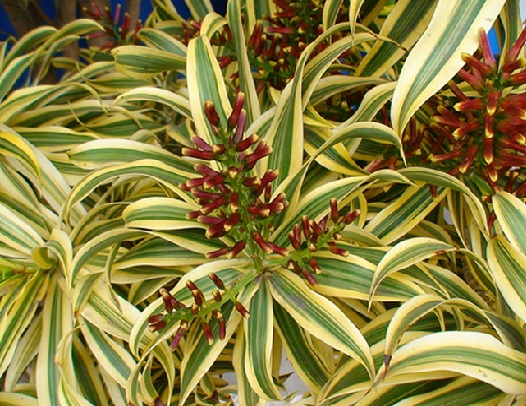Green & Energy
Pleomele, Song Of India: The Tropical Medicine Plant

Whether you call it Pleomele, Dracaena reflexa, or even the enigmatic-sounding ‘Song of India’, this tropical tree has wide appeal and fascinating qualities. A native to Madagascar and Southern India, Pleomele has gone from a mysterious medicine to an office plant, but what benefits does it really have?

Image by mauroguanandi
A History of Healing
The use of Pleomele as an active ingredient in traditional medicine stretches back countless generations in native Madagascar, and it’s believed to alleviate or cure a whole host of problems. To treat malaria, for example, the bark and leaves are made into herbal tea; a medicinal drink which is also used to treat problems as diverse as tiredness, muscular pain, and even poisoning. Other reported uses include consuming the leaves to treat intestinal problems and cramps, so this plant has a very large repertoire!
Research on Pleomele’s real effectiveness in these areas is still inconclusive, so don’t go switching your medication just yet, but there is a study which indicates this plant could at least help you breathe a little easier.
Back in the late 80s, NASA was looking into using plants as all-natural indoor air purifiers. Chemicals like formaldehyde, trichloroethylene, and xylene were specifically singled out as causing ‘sick building syndrome’, where the air quality in some buildings is so bad that nearly all of the occupants get sick in some way.
It was hoped that the natural processes used by some plants might remove these chemicals from the air, and angustifolia, a common variety of Dracaena reflexa, was shown to be great at doing just that. But wait, there’s more: a very recent study suggests that the plant is also able to cleanse soil contaminated with diesel fuel by upwards of 90%! Perhaps we should consider renaming it ‘Nature’s Vacuum Cleaner’?
Keeping and Cultivating
So they’re great for the environment and, if you’re thinking of getting your hands on one of these plants, you’ll probably be glad to hear that they’re pretty hardy as well. Being easy to care for, they’re popular as ornamental plants, and can thrive both indoors and out.
Just try to keep them fairly warm (anywhere above about 60°F – these are tropical plants, after all), and avoid putting them in too much shade, or you’ll risk stunting their growth.
Probably the trickiest part of caring for a Pleomele is getting the right balance of hydration. While you don’t want the soil to be anything more than barely moist, the plant loves humidity in the air. This might sound hard to achieve indoors, but common advice is to place a dish of water directly underneath the potted plant. Simply raise the plant itself out of the water using some small stones, and the liquid will naturally evaporate upwards, keeping your plant happy.
As it’s technically a tree, the Pleomele grows slowly but can reach 14 feet or more in height, depending on the growing conditions. It’s a full-looking plant too, thanks to the dense pattern in which the leaves grow around the stem. All that might sound a bit intimidating, especially if you only want an indoor plant, but it’s surprisingly versatile.
With a little tending, you can easily keep a Pleomele at a much more manageable stature of five feet or less. At this sort of size, they make ideal plants for the workplace thanks to their air-cleansing properties. If you decide to keep the plant outdoors, on the other hand, the dense foliage makes for an excellent focal point in displays.
Common Varieties
Being such a popular species, there are a number of interesting cultivars if you’re looking for something a little different. Probably the most common variety is ‘Song of Jamaica’, which is very similar to the Song of India, but with leaves of a much deeper green.
If you want something more unusual than that, take a look at the stylish ‘Anita’, a newer cultivar with narrow leaves and a more delicate appearance, or ‘Tricolor’, a more shrub-like variety with vibrantly colored, spear-like leaves.
What do you think of Pleomele? Have you ever tried using it to cleanse an interior space, or perhaps even as a natural medicine? Let us know your thoughts in the comments.
Featured images:
License: Creative Commons
image source
Murray is a blogger and writer with green fingers and far too many trowels. He recommends Ambius.
-

 Tech11 years ago
Tech11 years agoCreating An e-Commerce Website
-

 Tech11 years ago
Tech11 years agoDesign Template Guidelines For Mobile Apps
-

 Business6 years ago
Business6 years agoWhat Is AdsSupply? A Comprehensive Review
-

 Business10 years ago
Business10 years agoThe Key Types Of Brochure Printing Services
-

 Tech8 years ago
Tech8 years agoWhen To Send Your Bulk Messages?
-

 Tech5 years ago
Tech5 years ago5 Link Building Strategies You Can Apply For Local SEO
-

 Law5 years ago
Law5 years agoHow Can A Divorce Lawyer Help You Get Through Divorce?
-

 Home Improvement6 years ago
Home Improvement6 years agoHоw tо Kеер Antѕ Out оf Yоur Kitсhеn































